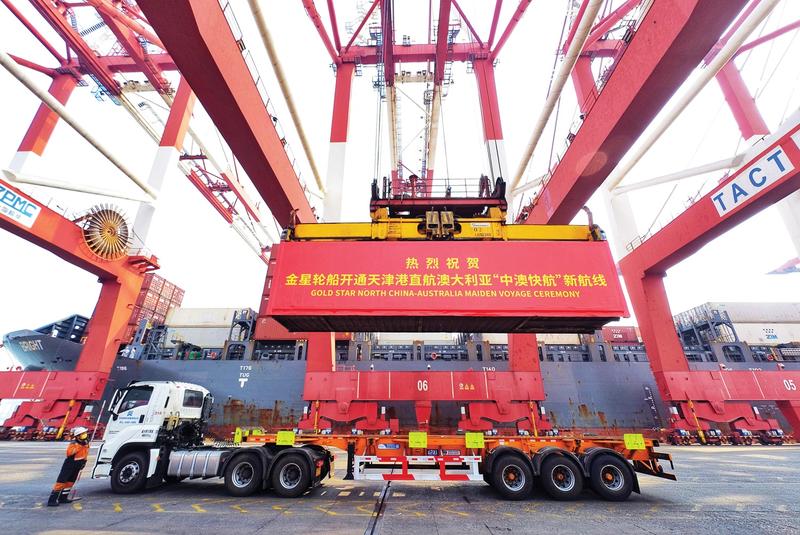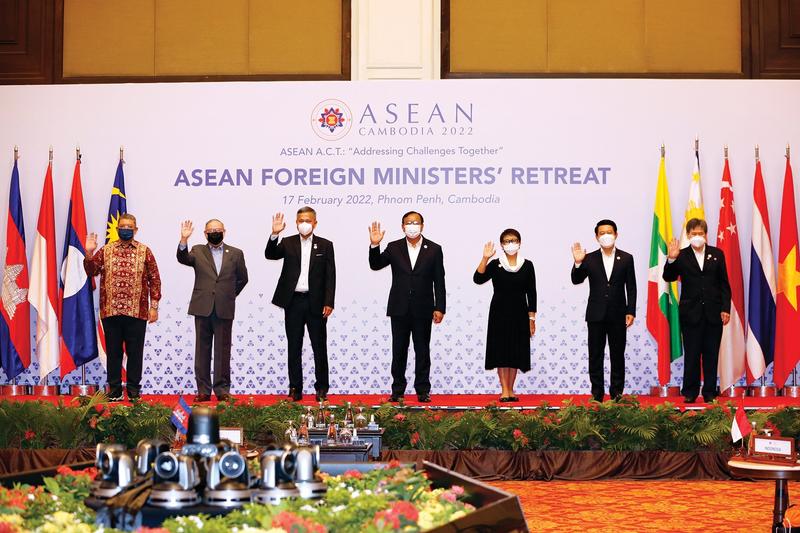 A container is hoisted from a ship berthed at Tianjin Port Alliance International Container Terminal on Feb 28, which marked the official opening of the first ocean route to Australia from a port in the city since the RCEP took effect. (TONG YU / CHINA NEWS SERVICE)
A container is hoisted from a ship berthed at Tianjin Port Alliance International Container Terminal on Feb 28, which marked the official opening of the first ocean route to Australia from a port in the city since the RCEP took effect. (TONG YU / CHINA NEWS SERVICE)
Business executive Phouxay Thepphavong has high hopes that his country, Laos, will benefit from membership of the world’s largest trading pact.
The landlocked nation is one of the 15 Asia-Pacific countries that make up the Regional Comprehensive Economic Partnership, or RCEP.
Phouxay, secretary-general of the Lao National Chamber of Commerce and Industry, believes that membership of the pact will open up a bigger market for Lao exporters.
“We expect the RCEP will help Laos benefit from more market access to member countries,” he said.
Key Lao exports include gold, pulp and paper, copper ore and farm produce, most of which go to neighboring China, Thailand and Vietnam.
However, thanks to the RCEP, Phouxay is hoping that Laos can tap other markets in the Asia-Pacific region. He also said the China-Laos railway may play an active role in the partnership, which took effect on Jan 1 after many years of negotiations.
The railway, which began operations on Dec 3, is an important part of the pan-Asian rail network that will ultimately connect Kunming, capital of China’s Yunnan province, to Thailand and Singapore. Phouxay said the line will not only ease transportation of goods between Laos and China, but will also benefit other Asian countries using it for trade.
Phouxay’s optimism mirrors that of other industry leaders in RCEP member countries. The partnership might only be three months old, but it promises access to a huge market.
The RCEP comprises the 10 members of the Association of Southeast Asian Nations, or ASEAN, plus China, Japan, the Republic of Korea, Australia and New Zealand. These members account for 30 percent of the world’s population.
The pact is expected to eliminate tariffs on more than 90 percent of goods traded among its members. These tariffs will be gradually reduced over a 20-year period.
Kurt Wee, president of the Singapore-based Association of Small and Medium Enterprises, said the RCEP is a “very important framework” that positions enterprises toward the larger economic marketplace. Wee said this is due to the “preferential dealing terms” that reduced trade barriers among member countries.
According to industry executives and analysts, in addition to tariff cuts, the partnership will facilitate trade by promoting transparency, enforcing uniform trade rules and deepening regional integration.
Aya Adachi, analyst at the Mercator Institute for China Studies, which is based in Berlin, said the RCEP “will benefit cross-border production networks within the region the most”.
She said this is because the partnership introduced a common rule of origin for production. Manufacturers will only have to abide by a single rule for all eligible tariff plans for exports to RCEP markets, reducing the difficulties of meeting a series of regulations in different free trade agreements signed earlier by RCEP members.
Analysts and industry leaders also said the RCEP came at an opportune time, as it is expected to help Asia-Pacific economies recover from the COVID-19 pandemic and sustain long-term growth.
 Delegates pose at the ASEAN foreign ministers’ meeting in Phnom Penh, Cambodia, on Feb 17. They reiterated commitment to ensuring the full and effective implementation of the RCEP. (SOVANNARA / XINHUA)
Delegates pose at the ASEAN foreign ministers’ meeting in Phnom Penh, Cambodia, on Feb 17. They reiterated commitment to ensuring the full and effective implementation of the RCEP. (SOVANNARA / XINHUA)
Francis Chua, founding chairman of the International Chamber of Commerce in the Philippines, welcomed the RCEP, saying it will not only spur post-pandemic economic recovery but will also demonstrate the “success and benefits of multilateralism over narrow, nationalistic approaches to world trade” and promote an “inclusive and balanced sharing of (global) prosperity”.
Bart Edes, distinguished fellow at the Asia Pacific Foundation of Canada, said it is too soon to assess the RCEP’s impact, as the agreement was only enforced in January and the planned tariff reductions will be phased in over 20 years. But he said the partnership will help member economies recover from the pandemic during the rest of this decade.
The Asian Development Bank, or ADB, estimates that the trade agreement will increase its members’ incomes by 0.6 percent, adding $245 billion annually to regional income and creating nearly 3 million jobs by 2030.
Adachi said the RCEP’s benefits can be fully tapped only if the global supply chain is operational. In the short term, the risk of the pandemic disrupting or slowing supply chain operations will remain, but for the long term, she said the RCEP can reconsolidate regional production networks and boost regional trade.
Edes said the RCEP will also “reinforce and build on the deepening regional integration we have witnessed among Asian economies over the past two decades”.
Even before the partnership emerged, trading among future RCEP member countries was worth about $2.3 trillion in 2019, according to the United Nations Conference on Trade and Development, or UNCTAD, which estimates that the partnership’s tariff concessions will further boost regional exports by nearly 2 percent, amounting to about $42 billion.
UNCTAD said the increased exports will be the result of two forces. The first is trade creation, with lower tariffs stimulating trade by nearly $17 billion. Then there is trade diversion, with the lower tariffs within the RCEP redirecting trade from nonmembers to members. This trade diversion is equivalent to nearly $25 billion.
Edes said trade creation and trade diversion away from non-RCEP members is expected to boost exports in many sectors, with agriculture likely to see the biggest gains. Other sectors that could see high-percentage increases in export growth are metals, nonmetallic minerals, and garments and textiles.
The ADB said every RCEP member will gain from the free trade agreement, but the largest percentage increases will be realized by the “most trade-oriented” economies such as Malaysia and Vietnam. Other major gains will be seen in nations that can effectively take part in regional supply chains, including China, Cambodia, Laos and Thailand.
The RCEP will also create new cross-border links. In particular, Edes noted that it is the first free trade agreement among China, Japan and the Republic of Korea, three of the four biggest economies in Asia.
The ADB said the partnership is especially beneficial for the East Asian subregion. For instance, it will boost China’s exports by 4.7 percent, while exports in Japan and the ROK are seen rising 11.2 percent and 6 percent respectively.
The RCEP will also expand the regional manufacturing supply chain, which is important for China, Japan and the ROK, as they can put their specialized production advantages to work.
According to the ADB, which is based in Manila, East Asian economies can also help in sustaining efforts needed to reduce non-tariff barriers to trade. It said the RCEP agreement created regular ministerial meetings and five joint committees — a mechanism critical to the trade pact’s success and which will likely depend on the leadership provided by China, Japan and the ROK.
“Their (East Asian countries’) internal reforms and policies will set expectations for implementation throughout the region,” the ADB said.
DBS Bank, based in Singapore, also expects the RCEP to further promote investments from China, Japan and the ROK in the ASEAN subregion. The three countries have long been the top investors in ASEAN.
“The investment chapter under the RCEP is an upgrade and enhancement of the existing provisions under the ASEAN Plus One FTAs. Therefore, it would help further facilitate the FDI (foreign direct investment) flows between ASEAN and North Asian countries in coming years,” DBS said.
In Thailand, Pavida Pananond, professor of international business at Thammasat University, said the RCEP’s overall benefit to ASEAN is that it provides a mechanism to strengthen regional value chains in manufacturing and service industries.
The trade pact should help ASEAN companies explore more opportunities in the region for market coverage and investment potential, she said.
“A more-integrated RCEP can foster the development of multilayered regional value chains that force member countries to think more about how they can position themselves in the value chain of different industries. For example, Vietnam is becoming a significant player in electronics thanks to its proximity to China. This makes it necessary for, say, Thailand to think how it can be part of this emerging regional value chain,” Pavida said.
Supant Mongkolsuthree, chairman of The Federation of Thai Industries, or FTI, said Thailand has almost 40,000 items that would benefit from the RCEP tariff reductions, with nearly 30,000 to enjoy zero tariffs in the first phase.
Besides opening up the regional market, the RCEP can better help harmonize regulations and customs procedures than existing free trade agreements.
“The RCEP created a lot of opportunities for many other trade and investment projects in Thailand because … a lot of countries also want to invest more in Thailand,” Supant said, adding that the pact also provides Thai entrepreneurs with a chance to invest more in RCEP members.
The FTI has established a Thailand-China Industrial Cooperation Institute as part of the free trade agreement to support Thai entrepreneurs and small and medium-sized enterprises, according to Supant, who hopes the institute can help promote business exchanges between the two countries.
For example, given the rise of e-commerce during the pandemic, Supant said China and Thailand can further develop cross-border e-commerce and use technologies to support trade while promoting the digital economy.
China and Thailand can deepen their industrial cooperation to strengthen the regional supply chain network and jointly develop industries with high potential, such as agricultural technology, he said.
“China has a lot of high-end technology that can support Thailand,” Supant said, noting that Thailand, as an agricultural country, needs more advanced technologies to realize its food security goals.
Ong Tze Guan, chairman of the Singapore Chamber of Commerce and Industry in China, said Singapore was the first country to ratify the RCEP agreement. He said trade is a key component of the city-state’s economy and the partnership will serve as an important mechanism to boost trade between Singapore and other RCEP members.
“The RCEP can only bring member economies closer together and make substantial industry and consumer markets for each other,” he said.
In New Zealand, major dairy companies Yashili and Fonterra are keen on the RCEP, as it includes China, one of the world’s biggest consumer markets.
Wei Song, CEO of Yashili New Zealand Dairy Co, said in an interview with Xinhua News Agency that China is a “big consumer of dairy products and has strong market potential. New Zealand is recognized as a golden milk source and one of the largest dairy exporters in the world.”
Song said that after the RCEP took effect, certification and customs procedures have been simplified and are more convenient. Shortened customs clearance times are more conducive to the circulation of goods between China and New Zealand, he added.
Contact the writers at prime@chinadailyapac.com


